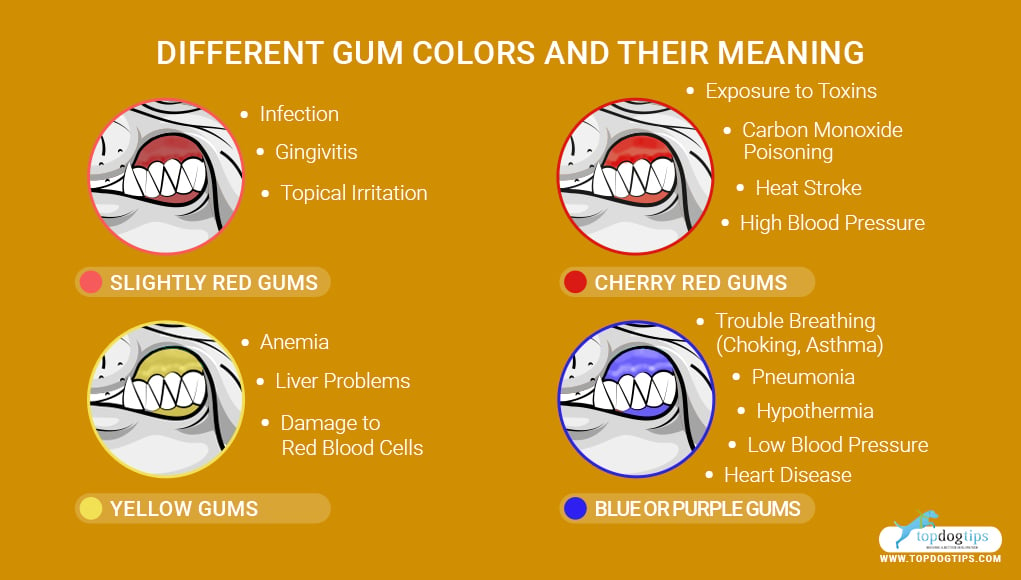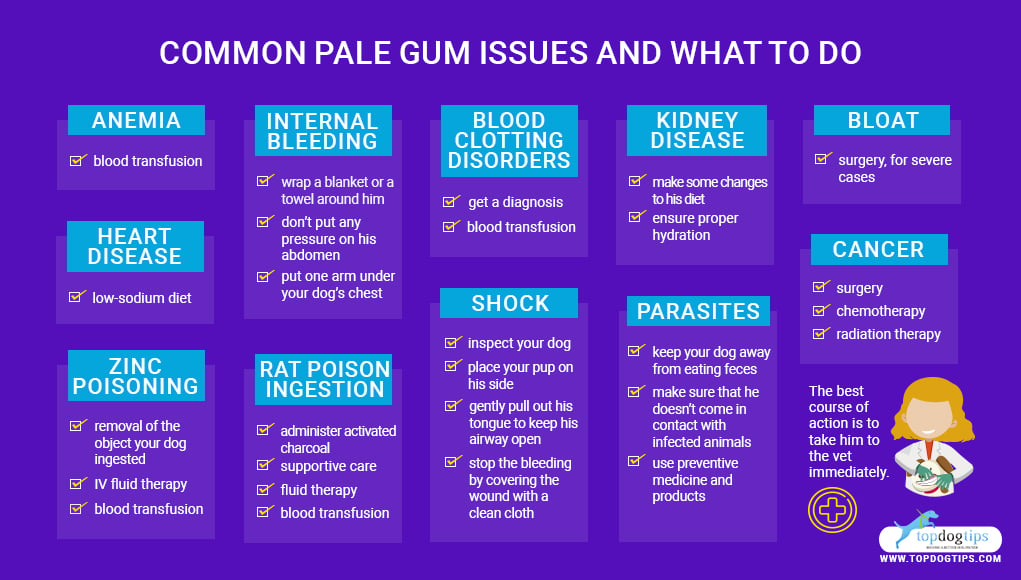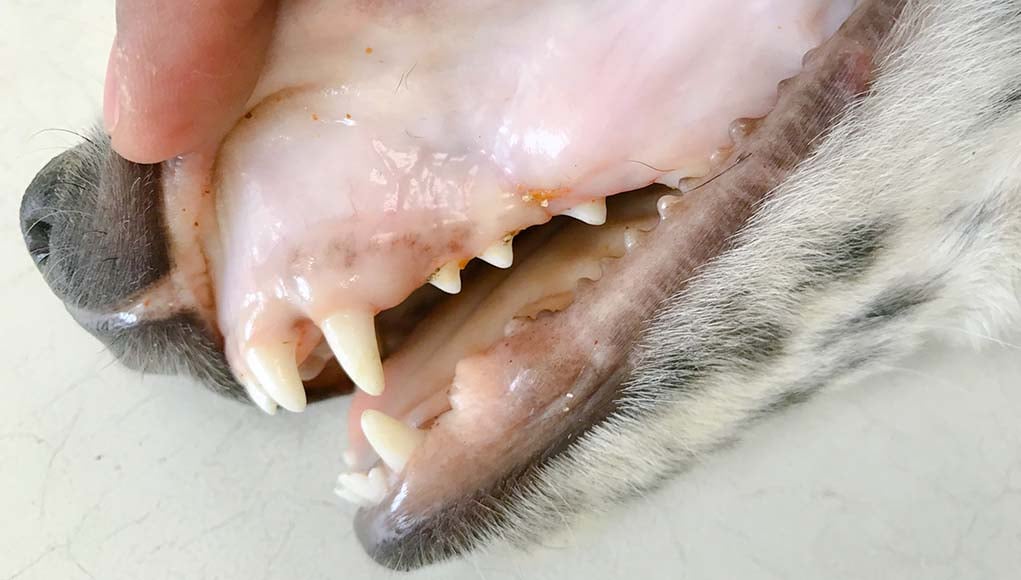Table of Contents
The same way that you can learn something about a person’s health by the color of their face, you can learn a lot about a dog’s overall health by the color of their gums.
Forget about the old tale about the wet nose being an indicator of your dog’s health – pay attention to your dog’s gums instead because pale gums in dogs can tell you a few things.
What Do Healthy Dog Gums Look Like?
A healthy dog has gums that look the same as gums of a healthy human.
They should be salmon pink and a little bit shiny. Here's what healthy gums in dogs look like:

When you inspect your dog’s gums, you can press them and healthy ones turn white for a couple of seconds before they return to their regular, pink color.
If they don’t return to their normal color within 2 seconds, your dog may have some health issues.
However, some dogs may have pigment on their gums. If your pooch does have such pigment, looking at his gums will not tell you much about your pet's health.
Instead, you should look at your dog’s eye lining or his inner eyelid.
Your dog’s inner eyelid should look the same as yours.
How to Examine Your Dog’s Gums
Before you come to any conclusions about your dog’s health based on the color of his gums, you must first learn how to properly examine them.
Check His Gums When He’s Healthy – The first step is to take a look at your dog’s gums when your pet is healthy.
Lift their upper lip to reveal the gums and take a look at the color.
Make a Note – When you take a look at the color of your dog’s gums, make a mental note about it.
This will help you notice any differences in color if they occur. You can even take a photo for future reference.
Check Gums Regularly – Make a habit out of checking the color of your dog’s gums.
If you do this regularly, you will be able to spot any potential health problems on time.
Looking at his gums once or twice a month should be enough.
The best and easiest way to monitor your pup's gums is to take a quick glance whenever you're brushing their teeth. Ideally, you're doing this once a day or at least a few times a week, which is a good enough time to keep your eye on the dog's gums color.

Different Gum Colors and Their Meaning
Before we focus on pale gums in dogs and what they could indicate, let’s take a quick look at some other gum colors you may notice on your pooch and what they could mean.
Slightly Red Gums – Infection, Gingivitis, Topical Irritation
Cherry Red Gums – Exposure to Toxins, Carbon Monoxide Poisoning, Heat Stroke, High Blood Pressure
Yellow – Anemia, Liver Problems, Damage to Red Blood Cells
Blue or Purple – Trouble Breathing (Choking, Asthma), Pneumonia, Hypothermia, Low Blood Pressure, Heart Disease
If you've made a habit out of checking your dog's gums every time you brush their teeth, spotting these different colors will be quick and easy.
You can also always have a photo of your dog's healthy gums for reference and to compare.

Pale Gums in Dogs and What They Mean
If you notice that your dog’s gums are pale pink or white, it could indicate a wide variety of potential health problems. Here are some of the most common issues associated with pale gums in dogs.
1. Anemia
Anemia is a reduced number of circulating red blood cells, hemoglobin, or both.
Other symptoms of anemia in dogs include weakness, difficulty breathing, weight loss, faster heart rate, vomiting, and signs of blood loss, like bloody nose or blood in stool or urine.
It is important to note that anemia is not actually a disease itself, but it is a common sign of some other medical problem.
What to Do:
If your dog’s anemia is severe, it may be necessary for him to receive a blood transfusion. For any further treatment, it is necessary to diagnose the underlying cause at the vet's office and develop an appropriate treatment plan.
2. Shock
Shock is the most common cause of death for dogs in accidents. It is an extreme reaction to any serious injury that affects the dog's body, like a large external wound or internal bleeding.
When this happens, your pet's body will try to compensate for the loss of blood by speeding up the heart rate in order to prevent low blood pressure. However, your dog’s blood vessels will become narrow during shock and your dog’s gums may not receive enough blood and thus turn pale or white.
In addition to pale gums in dogs, other signs of shock include rapid breathing, a rapid heartbeat, weakness and inability to stand, or low body temperature.
What to Do:
The first thing to do is to inspect your dog for symptoms.
If you determine that he is in shock, the best course of action is to take him to the vet immediately.
However, you can also do a few things to provide immediate help to your pooch, especially if the dog's shock is caused by external bleeding.
First, place your pup on his side and gently pull out his tongue in order to keep his airway open.
If there is visible external bleeding, try to stop it by covering the wound with a clean cloth and apply pressure while on the way to seek veterinary care.
3. Internal Bleeding
While internal bleeding is one of the reasons your dog may go into shock, sometimes it may not be so severe to cause this type of reaction.
However, if your dog’s gums are pale or white in color, this may be caused by internal bleeding.
Internal bleeding in dogs can be caused by many factors, including injury, liver or spleen tumors, stomach ulcers, etc.
Pay attention to other symptoms of internal bleeding, like black or tarry stools, lethargy, distended abdomen, vomiting and collapse.
What to Do:
If you suspect that your dog has internal bleeding, try to keep him calm and relaxed. Wrap a blanket or a towel around him and talk to him softly.
The next step is taking your dog to the vet as soon as you can.
When you pick up your dog to carry him to the car, don’t put any pressure on his abdomen.
Instead, put one arm under your dog’s chest, right in front of his front legs.
Place the other arm behind his back legs.
4. Blood Clotting Disorders
Pale gums in dogs can also be a sign of a blood clotting disorder. This condition means that a dog’s blood doesn’t coagulate as well as it is supposed to, which can lead to excessive or abnormal bleeding.
Some conditions that cause this include Von Willebrand's Disease, Immune-Mediated diseases, thrombocytopathy, and thrombocytopenia (platelet disorders).
Other signs of a blood clotting disorder include bleeding, blood in stool or urine, bruises on the skin and petechiae (tiny brown or red spots on the skin).
What to Do:
If your dog is bleeding and you can’t stop it, he may have a blood clotting disorder. Take your dog to the vet immediately for a diagnosis and a blood transfusion, if necessary.
5. Kidney Disease
Your dog’s kidneys naturally produce erythropoietin, a hormone that assists the bone marrow to make red blood cells.
If your pooch suffers from kidney disease, like chronic renal failure, he will have less of this hormone and he may develop anemia and have pale gums.
Other symptoms of chronic kidney disease in dogs include dehydration, increased water consumption and urination, urinary incontinence, reduced appetite, lethargy, vomiting, weight loss and oral ulcers.
What to Do:
If you suspect that your dog has some kind of a kidney problem, take him to the vet to get a diagnosis.
If he suffers from chronic renal failure, you will have to make some changes to his diet and ensure proper hydration in order to manage this condition.
6. Bloat
Canine bloat is a very serious condition.
In fact, bloat can be fatal if left untreated for too long.
In addition to pale gums in dogs, which can appear if stomach torsion prevents blood from getting back to the heart from the lower body, other symptoms of bloat include enlargement of the dog’s abdomen, retching, restlessness, salivation and distress.
What to Do:
Bloat is a life-threatening emergency, and it requires immediate veterinary care.
If your dog does have bloat with twisting of the stomach, he will have to go into surgery.
7. Parasites
A severe parasite infestation can lead to many problems for your pooch, like the parasitic anemia.
Pale gums and other symptoms like fever, lack of energy and appetite, weight loss, colored urine, etc. can signal a parasitic infection.
The most common parasitic infections in dogs are intestinal worms but your dog can also suffer from a severe flea infestation.
What to Do:
Preventing parasitic infections is possible, so try to keep your dog away from eating feces, drinking stale water and make sure that he doesn’t come in contact with infected animals.
You can also use preventive medicine and products, both for internal and external parasites.
However, if your dog is already suffering from a parasitic infestation, your vet will most likely prescribe antibiotics and send your pooch home.
But if your dog has parasitic anemia, your vet may also prescribe steroid therapy or, in more severe cases, fluid therapy or even blood transfusion.
8. Rat Poison Ingestion
If your dog eats rat poison (or any other type of rodent poison), he will probably get exposed to warfarin, which is an anticoagulant that may lead to profuse bleeding from nose, mouth or even rectum or vagina.
Other than bleeding and having pale gums, your pooch may also show other signs like difficulty breathing, coughing, black stools, vomiting, lethargy and collapse.
What to Do:
If the rat poisoning was ingested recently, your vet may induce vomiting and administer activated charcoal to prevent further absorption of this dangerous chemical.
If clinical signs have developed, your dog may require supportive care, including fluid therapy and blood transfusion. Left untreated, ingestion of rat poison can be fatal for your dog.
9. Zinc Poisoning
Zinc positioning, or zinc toxicity, happens when a dog ingests objects made of zinc, like pennies or nails.
While zinc is a natural part of your dog’s body, taken in excessive amounts it prevents the absorption of iron, which aids the production of red blood cells.
This will eventually lead to anemia and symptoms like pale gums in dogs as well as lack of appetite, vomiting, diarrhea, jaundice and lethargy.
What to Do:
The first step is the removal of the object your dog ingested, typically with surgery or endoscopy.
Your pooch will receive IV fluid therapy to promote urination, as well as certain drugs to help with the release of zinc from the body.
In severe cases, a blood transfusion may be necessary.
10. Heart Disease
Your dog may have pale gums if he suffers from heart disease.
Heart problems can lead to other health problems, like low blood pressure, rapid breathing, and coughing, weak pulse, and enlarged abdomen.
However, the symptoms will depend on the severity of the disease and may not be present at all if your dog’s heart problem is not serious.
If your dog is in Congestive Heart Failure, his gums will most likely be pale and even light blue due to decreased oxygen.
What to Do:
While treatments can’t reverse heart disease, your dog’s condition can usually be improved with medications and management with your veterinarian.
Your veterinarian may also recommend a cardiac diet.
Of course, you need to consult your vet before you make any changes to your dog’s diet.
11. Cancer
There are some types of cancer, like bone marrow cancer, which can lead to decreased blood cells production, which then leads to pale gums in dogs.
Other kinds of cancer, like those affecting the spleen and the liver, can cause internal bleeding in dogs.
All of this can cause pale or white gums in dogs, in addition to some other symptoms that depend on the type of cancer.
What to Do:
Therapy for cancer in dogs depends on the type and size of cancer.
Possible treatments include surgery, chemotherapy and radiation therapy, as well as some combination of these treatments.
How To Prevent Pale Gums In Dogs
Well, the first step is of course create a habit of examining your dogs.
You can do this by brushing your dog's teeth regularly, or just make sure to remember to check them.
Catching them early on gives you the best chances of narrowing down what went wrong if your dog's gums turn pale.
Also make sure your dog stays hydrated.
I live in a very hot area in South Florida and my dog has black fur, so she must drink more water than most dogs due to the heat here.
Lastly, vet checkups are the most important part of your toolkit to keep your pet healthy.
Taking them to regular checkups allows vets to put eyes, ears, and hands on a dog and detect signs of disease much earlier than pet parents.
In Summary
 The color of your dog’s gums can tell you a lot about his overall health. Healthy gums should be pink and a bit shiny.
The color of your dog’s gums can tell you a lot about his overall health. Healthy gums should be pink and a bit shiny.
If your dog’s gums are pale or white, it can be a sign of many possible health conditions.
These include shock, anemia, blood clotting disorders, internal bleeding, zinc toxicity, ingestion of rat poison, kidney disease, heart disease, etc.
When you notice pale gums in dogs and aren't sure of the reason, it's best to take your pooch to the vet to determine the underlying cause and develop a treatment plan.
Why You Should Trust Top Dog Tips
Well, as dog owners, we also want to know as much as we possibly can and find “the truth” out there in dog ownership.
We want to clear the fog that surrounds certain topics like nutrition, dog care, dog health, and more.
So we went ahead and brought aboard not only long-time dog owners but Veterinarians onto our website.
For each article we publish, we want to make sure the information is accurate and has been vetted by real veterinarians.
READ NEXT: 12 Complications That Develop When You Ignore Your Dog’s Dental Health













